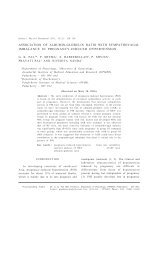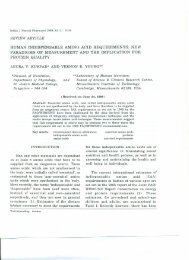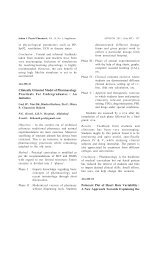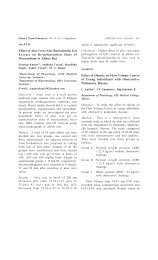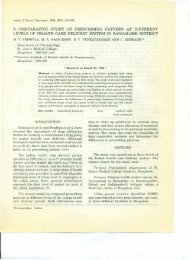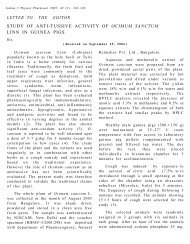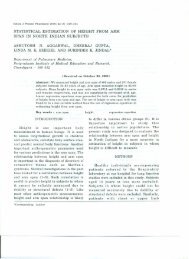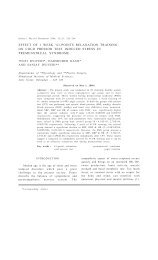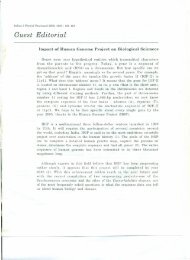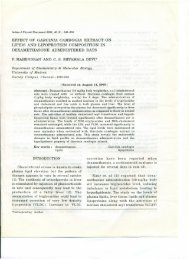PEAK EXPIRATORY FLOW RATE IN FLOUR MILL WORKERS ...
PEAK EXPIRATORY FLOW RATE IN FLOUR MILL WORKERS ...
PEAK EXPIRATORY FLOW RATE IN FLOUR MILL WORKERS ...
You also want an ePaper? Increase the reach of your titles
YUMPU automatically turns print PDFs into web optimized ePapers that Google loves.
Indian J Physiol Pharmacol 1998; 42 (4) : 521-526<br />
<strong>PEAK</strong> <strong>EXPIRATORY</strong> <strong>FLOW</strong> <strong>RATE</strong> <strong>IN</strong> <strong>FLOUR</strong> <strong>MILL</strong> <strong>WORKERS</strong><br />
SANJAY P. ZODPEY* AND RAJNARAYAN R. TIWARI**<br />
*Department of Preventive and Social Medicine &<br />
Clinical Epidemiology Unit,<br />
Govt. Medical College, Nagpur - 440 003<br />
and<br />
**Department of Preventive and Social Medicine,<br />
Indira Gandhi Medical College, Nagpur - 440 018<br />
(Received on August 29, 1997)<br />
Abstract: The current cross-sectional study with a comparison group was<br />
undertaken to investigate peak expiratory flow rate (PEFR) in flour mill<br />
workers and to study relationship between reduction in PEFR and age,<br />
smoking, exposure to grain dust and respiratory morbidity. The study<br />
included 286 flour mill workers and equal number of neighbourhood controls<br />
group-matched for age.PEFR was measured by using Wright's Peak Flow<br />
Meter. PEFR was significantly reduced in flour mill workers as compared<br />
to comparison group. The decline in PEFR was significantly associated<br />
with grain dust exposure, duration of exposure, tobacco smoking and<br />
presence of respiratory morbidity.<br />
Key words: flour mill workers<br />
respiratory morbidity<br />
PEFR<br />
grain dust exposure<br />
<strong>IN</strong>TRODUCTION<br />
The International Symposium on the<br />
Effects of Grain Dust on Human Health held<br />
at the University of Saskatchewan during<br />
7-9 November 1977 has endorsed the<br />
respiratory effects of exposure to grain dust<br />
and impairment of lung function among<br />
flour mill workers (1). Since then studies of<br />
respiratory morbidity and lung function<br />
assessment have been performed among<br />
workers from various occupations where<br />
exposure to grain dust is encountered which<br />
included dock workers, grain storage<br />
workers; longshoremen, flour mill workers,<br />
grain transporters and bakers in different<br />
parts of the world 0-4).<br />
However, the results of previous studies<br />
are inconsistent, particularly in relation to<br />
lung function impairment in flour mill<br />
workers (1-6). With this background and<br />
fortified by the fact that no comprehensive<br />
literature is available on lung function<br />
assessment in flour mill workers across the<br />
country including Central India and<br />
considering unorganized nature of this<br />
industry, we have carried out a crosssectional<br />
study with a comparison group to<br />
investigate PEFR in flour mill workers and<br />
*Corresponding Author and address: Plot No. 305, Hanuman Nagar, Nagpur - 440 009<br />
-----------------------------
522 Zadpey and Tiwari<br />
its relationship with age, tobacco smoking,<br />
grain dust exposure and its duration and<br />
presence of respiratory morbidity.<br />
METHODS<br />
The present study was designed as a<br />
cross-sectional study with a comparison<br />
group. For the selection of study subjects,<br />
Nagpur city was divided in five zones, out<br />
of which South zone was randomly selected.<br />
The list of all the workers i.e. 320, working<br />
in flour mills of the South zone was<br />
prepared for the purpose of the study.<br />
However, 34 workers could not participate<br />
in the study for various reasons. Thus, study<br />
finally included 286 flour mill workers. All<br />
the study subjects were males. The study<br />
subjects were group matched for age with<br />
the neighbourhood controls. The exclusion<br />
criteria for the controls included exposure<br />
to any kind of dusty environment by virtue<br />
of their occupation. The interview technique<br />
was used as a tool of data collection which<br />
included details regarding age, smoking<br />
habits, duration of grain dust exposure and<br />
presence or absence of respiratory symptoms<br />
or signs. The standard diagnostic criteria<br />
were used for the diagnosis of respiratory<br />
morbidities (7). The PEFR was measured<br />
with the help of Wright's Peak Flow Meter<br />
and the best of the three readings was<br />
noted. The classification of PEFR into<br />
reduced or normal PEFR was based on the<br />
calculation of predicted PEFR by the<br />
formula-663.4-3.37 (age in years) + 7.86<br />
(height in ems) ± as 84 as described by<br />
Dikshit and Jog (8). Statistical analysis<br />
included tests of significance for means i.e.<br />
t-test, z-test and analysis of variance<br />
(ANOVA). Univariate analysis was carried<br />
out considering PEFR (outcome variable) as<br />
Indian J Physial Pharmacal 1998; 42(4)<br />
a continuous variable. To study the<br />
association between reduced PEFR and age,<br />
tobacco smoking, exposure to grain dust,<br />
duration of exposure and respiratory<br />
morbidity, Unconditional Multiple Logistic<br />
Regression Analysis (9) was performed by<br />
using "MULTLR" statistical software<br />
package. Logistic regression analysis is<br />
recommended for use in the study of<br />
complex etiological processes, where many<br />
variables may influence the disease risk. For<br />
these multivariable situations, it may be<br />
desirable to estimate independent and joint<br />
effects with a mathematical model. In the<br />
logistic model, the conditional probability<br />
of disease (D) occurrence given exposure (E)<br />
IS represented by a linear function:<br />
logit P (DIE) = In<br />
[P(DIE)]<br />
[l-P(DIE)]<br />
a + bE<br />
where logit is an abbreviation of<br />
logarithmic unit, in the natural logarithm,<br />
P(D I E) = probability of disease given<br />
exposure; a, ~ = regression coefficients; and<br />
E is dichotomized as: (O=no exposure,<br />
l=exposure). This simple model I?ay be<br />
extended to take into account for potential<br />
confounders and effect modifiers (9). The<br />
multivariate analysis was carried out by<br />
converting best PEFR estimates into<br />
discrete variable by dichotomizing into<br />
reduced/normal PEFR.<br />
RESULTS<br />
All the 286 subjects in each group were<br />
males. Table I shows age wise distribution<br />
of PEFR among flour mill workers and<br />
comparison group subjects. Two way<br />
ANOVA revealed that there is a significant<br />
difference in mean observed PEFR of flour
Indian J Physiol Pharmacol 1998; 42(4) PEFR in Flour Mill Workers 523<br />
TABLE I : PEFR (L/min) according to age groups among study subjects.<br />
Age Flour mill wokrers Comparison group<br />
groups n Test results<br />
(in years) MOP" SD* MOP SD<br />
< 20 83 481.21 34.1 583.17 34.7 z=19.1, df=l, P
524 Zodpey and Tiwari<br />
significantly lower PEFR values than exsmokers<br />
(t=3.89, df=70, PO.05). When the PEFR<br />
of smokers was compared with the nonsmokers<br />
then the difference revealed<br />
statistically significantly reduced PEFR of<br />
smokers than non-smokers (z = 9.14, df=l,<br />
P
Indian J Physiol Pharmacol 1998; 42(4) PEFR in Flour Mill Workers 525<br />
TABLE V : Results of unconditional Multiple Logistic Regression Analysis.<br />
Risk factors Odds ratio 95% CI P value<br />
Full Model<br />
Age 0.78 0.60-1.26 >0.05<br />
Graindust exposure 1.96 1.60-2.21
526 Zodpey and Tiwari<br />
Except age, four other factors i.e. grain<br />
dust exposure, duration of exposure, tobacco<br />
smoking and presence of respiratory<br />
morbidity were significantly associated with<br />
reduction in PEFR in the final model of<br />
Unconditional Multiple Logistic Regression<br />
Analysis. Role of these factors in reducing<br />
PEFR is well known and reported in the<br />
literature (4, 5, 10, 11).<br />
The findings of this study recognised<br />
role of grain dust for a longer duration in<br />
Indian J Physiol Pharmacol 1998; 42(4)<br />
decline of PEFR among flour mill workers.<br />
Moreover, the nature of this industry<br />
is "unorganised" and scattered all over<br />
the country sporadically. Hence, no<br />
comprehensive occupational health package<br />
is available for the health care and welfare<br />
of these workers. Additionally very few<br />
studies have been conducted in India among<br />
this group of workers to assess lung function<br />
and respiratory morbidity. Thus, there is a<br />
need to undertake more elaborate research<br />
in this group of workers.<br />
REFERENCES<br />
1. Cotton DJ, Dosman JA. Symposium: Grain Dust<br />
and Health. 1. Host factors. Ann Int Med 1978; 88:<br />
840-841.<br />
2. Backmann M, Myers JE. Grain dust and<br />
respiratory health in South African milling<br />
workers. Br J Ind Med 1991; 48: 656-662.<br />
3. Taytard A, Tessier JF, Fauger JG et al.<br />
Respiratory function and bronchial reactivity in<br />
mill workers. Eur J Epidemiol 1988; 4: 326-330.<br />
4. Nag DP, Mukherjee AK, Rajan BK et al.<br />
Repiratory function among grain storage workers.<br />
Ind J Ind Med 1996; 42: 4-10.<br />
5. Taytard A, Tessier JF, Vergeret J et al.<br />
Respiratory function in flour mill workers.<br />
Eur J Epidemiol 1988; 4: 104-109.<br />
6. Musk AW, Venables KM, Crook B et al.<br />
Respiratory symptoms, lung function and<br />
sensitisation to flour in a British bakery. Br J<br />
l nd Med 1989; 46: 636-642.<br />
7. Crompton GK, McHardy GJR. Diseases of the<br />
respiratory system. In Christopher RW Edwards,<br />
Ian AD Bouchier. Davidson's Principles and<br />
Practice of Medicine, London, ELBS with<br />
Churchill Livingstone 1991; 376-409.<br />
8. Dikshit MB, Prasad BAK, Jog NV. Peak expiratory<br />
flow rate in elderly Indians. Indian J Physiol<br />
Phamcol 1991; 35: 39-43.<br />
9. Greenberg RS, Ibrahim MA. The case-control<br />
study. In Holland WW, Detels R, Knox G. Oxford<br />
Text book of Public Health, London, Oxford<br />
University Press 1985; 123-143.<br />
10. Culver BH, Butler J. Alterations in pulmonary<br />
function. In Principles of Geriatric Medicine ed.<br />
Andes R, Bierman EL and Hazzard WR. McGraw<br />
Hill Book Co.Ltd.(Lond.) 1985. chap.26: 280-287.<br />
11. Florey C du V, Leeder SR. Methods of cohort<br />
studies of chronic airflow limitations. WHO<br />
Regional Publications 1982; European Series<br />
No.12: 38-42.



